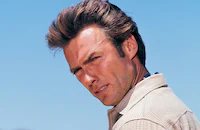Gary Cooper may have been tight-lipped in High Noon (1952) and James Stewart might have seemed ruthless in The Naked Spur (1953) but audiences could hardly have been prepared for the cold-hearted amorality personified by Eastwood in Leone's Italian Westerns.
Reprising his role as the nameless, virtually wordless, poncho-draped drifter, Eastwood finds himself competing against a Bible-toting walking arsenal named Colonel Mortimer (Lee Van Cleef), as they vie for the bounty on the head of the outlaw Indio (Gian Maria Volonte). The motivation of Eastwood's lone gunman (nicknamed "Monco," Italian for "monk") is stictly monetary, while Mortimer is driven by a lust for revenge. In spite of their differences, they form a brittle alliance to accomplish their shared goal, systematically outwitting and outgunning Indio's band of depraved desperados - including Klaus Kinski, upon whose hunched back Eastwood strikes a match in one moment of inspired black comedy.
Like the woolen serape and the weathered low-brimmed hat, the narrow toscani quickly became the Eastwood character's trademark. Leone (who died in 1989) once recalled that the actor pleaded with him to forego the Tuscan cigars in For a Few Dollars More. "We can't possibly leave the cigar behind," Leone responded, "It's playing the lead!" The same might be said of Ennio Morricone's score, which accentuates the film's barbarity with musical flourishes so stylized and grandiose they are almost comical, but which perfectly suit the exaggerated stylings of the Spaghetti Western.
Curiously, neither film would be released in the United States until 1967, by which time Leone and Eastwood had already completed their third collaboration, The Good, the Bad and the Ugly (1966). Eastwood's paycheck had increased from $15,000 for the first film to $50,000 for the second and would reach $250,000 (plus 10% of the grosses) for the third. Before the year was out, Italy could no longer afford the star it had created. Eastwood had graduated from character actor to big-screen sensation, a position he has carefully protected to this day.
Although For a Few Dollars More was two years old by the time it reached American screens, it was still a bit too "new" for many viewers. Numerous critics attacked the film's unique blend of graphic violence and morbid wit. The film was derided as "Western Grand Guignol" (Time), "a treat for necrophiles" (NBC's "Today Show"), and "constructed to endorse the exercise of murderers" (The New York Times). Little did they realize Leone and Eastwood's degenerate sagas helped revitalize the Western genre, even as they ushered in an era of heightened screen violence that would reach its peak with Sam Peckinpah's The Wild Bunch (1969). The morbid humor of For a Few Dollars More has likewise infected the American action film, and is clearly evident in the sarcastic benedictions muttered by stone-faced Stallones and Schwarzeneggers as they coldly dispatch their foes.
Producer: Arturo González, Alberto Grimaldi
Director: Sergio Leone
Screenplay: Sergio Donati (uncredited), Peter Fernandez (English dialogue), Sergio Leone, Fulvio Morsella (story), Luciano Vincenzoni
Production Design: Carlo Simi
Cinematography: Massimo Dallamano
Costume Design: Carlo Simi
Film Editing: Eugenio Alabiso, Adriana Novelli, Giorgio Serrallonga
Principal Cast: Clint Eastwood (The Man With No Name), Lee Van Cleef (Colonel Douglas Mortimer), Gian Maria Volonté (Indio), Joseph Egger (Old Prophet), Klaus Kinski (Hunchback), Mario Brega (Nino), Luigi Pistilli (Groggy), Benito Stefanelli (Luke).
C-132m. Letterboxed.
By Bret Wood




























